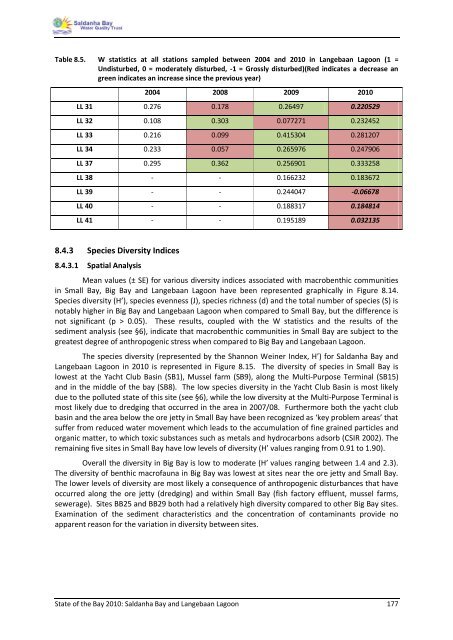State of the Bay Report 2010-Final - Anchor Environmental
State of the Bay Report 2010-Final - Anchor Environmental
State of the Bay Report 2010-Final - Anchor Environmental
Create successful ePaper yourself
Turn your PDF publications into a flip-book with our unique Google optimized e-Paper software.
Table 8.5. W statistics at all stations sampled between 2004 and <strong>2010</strong> in Langebaan Lagoon (1 =<br />
Undisturbed, 0 = moderately disturbed, -1 = Grossly disturbed)(Red indicates a decrease an<br />
green indicates an increase since <strong>the</strong> previous year)<br />
2004 2008 2009 <strong>2010</strong><br />
LL 31 0.276 0.178 0.26497 0.220529<br />
LL 32 0.108 0.303 0.077271 0.232452<br />
LL 33 0.216 0.099 0.415304 0.281207<br />
LL 34 0.233 0.057 0.265976 0.247906<br />
LL 37 0.295 0.362 0.256901 0.333258<br />
LL 38 - - 0.166232 0.183672<br />
LL 39 - - 0.244047 -0.06678<br />
LL 40 - - 0.188317 0.184814<br />
LL 41 - - 0.195189 0.032135<br />
8.4.3 Species Diversity Indices<br />
8.4.3.1 Spatial Analysis<br />
Mean values (± SE) for various diversity indices associated with macrobenthic communities<br />
in Small <strong>Bay</strong>, Big <strong>Bay</strong> and Langebaan Lagoon have been represented graphically in Figure 8.14.<br />
Species diversity (H’), species evenness (J), species richness (d) and <strong>the</strong> total number <strong>of</strong> species (S) is<br />
notably higher in Big <strong>Bay</strong> and Langebaan Lagoon when compared to Small <strong>Bay</strong>, but <strong>the</strong> difference is<br />
not significant (p > 0.05). These results, coupled with <strong>the</strong> W statistics and <strong>the</strong> results <strong>of</strong> <strong>the</strong><br />
sediment analysis (see §6), indicate that macrobenthic communities in Small <strong>Bay</strong> are subject to <strong>the</strong><br />
greatest degree <strong>of</strong> anthropogenic stress when compared to Big <strong>Bay</strong> and Langebaan Lagoon.<br />
The species diversity (represented by <strong>the</strong> Shannon Weiner Index, H’) for Saldanha <strong>Bay</strong> and<br />
Langebaan Lagoon in <strong>2010</strong> is represented in Figure 8.15. The diversity <strong>of</strong> species in Small <strong>Bay</strong> is<br />
lowest at <strong>the</strong> Yacht Club Basin (SB1), Mussel farm (SB9), along <strong>the</strong> Multi-Purpose Terminal (SB15)<br />
and in <strong>the</strong> middle <strong>of</strong> <strong>the</strong> bay (SB8). The low species diversity in <strong>the</strong> Yacht Club Basin is most likely<br />
due to <strong>the</strong> polluted state <strong>of</strong> this site (see §6), while <strong>the</strong> low diversity at <strong>the</strong> Multi-Purpose Terminal is<br />
most likely due to dredging that occurred in <strong>the</strong> area in 2007/08. Fur<strong>the</strong>rmore both <strong>the</strong> yacht club<br />
basin and <strong>the</strong> area below <strong>the</strong> ore jetty in Small <strong>Bay</strong> have been recognized as ‘key problem areas’ that<br />
suffer from reduced water movement which leads to <strong>the</strong> accumulation <strong>of</strong> fine grained particles and<br />
organic matter, to which toxic substances such as metals and hydrocarbons adsorb (CSIR 2002). The<br />
remaining five sites in Small <strong>Bay</strong> have low levels <strong>of</strong> diversity (H’ values ranging from 0.91 to 1.90).<br />
Overall <strong>the</strong> diversity in Big <strong>Bay</strong> is low to moderate (H’ values ranging between 1.4 and 2.3).<br />
The diversity <strong>of</strong> benthic macr<strong>of</strong>auna in Big <strong>Bay</strong> was lowest at sites near <strong>the</strong> ore jetty and Small <strong>Bay</strong>.<br />
The lower levels <strong>of</strong> diversity are most likely a consequence <strong>of</strong> anthropogenic disturbances that have<br />
occurred along <strong>the</strong> ore jetty (dredging) and within Small <strong>Bay</strong> (fish factory effluent, mussel farms,<br />
sewerage). Sites BB25 and BB29 both had a relatively high diversity compared to o<strong>the</strong>r Big <strong>Bay</strong> sites.<br />
Examination <strong>of</strong> <strong>the</strong> sediment characteristics and <strong>the</strong> concentration <strong>of</strong> contaminants provide no<br />
apparent reason for <strong>the</strong> variation in diversity between sites.<br />
<strong>State</strong> <strong>of</strong> <strong>the</strong> <strong>Bay</strong> <strong>2010</strong>: Saldanha <strong>Bay</strong> and Langebaan Lagoon 177

















